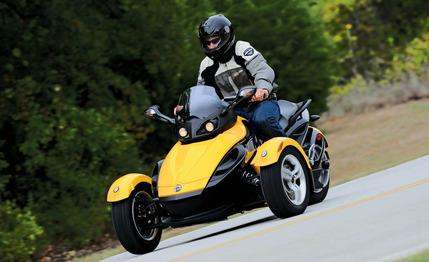 Mini Test Road Test
Mini Test Road Test
With a dominating presence in both the personal-watercraft market (Sea-Doo) and the snowmobile market (Ski-Doo), BRP (formerly Bombardier) has now set its sights on the much larger on-road segment. The two-wheeled-motorcycle market was deemed too difficult to crack, so the company produced a three-wheeled creation, a configuration chosen for its stability. And BRP desperately wants its Can-Am “Spyder Roadster” to be more than a motorcycle—consider the automotive terms “spyder” and “roadster” in its name, for instance. Some states agree: In California and Delaware, a standard driver’s license suffices.
Based on the company’s all-terrain-vehicle chassis, the two-passenger Can-Am spyder is all about user friendliness. It has a comfortable, upright seating position similar to that of a personal watercraft or snowmobile; a lockable, 1.6-cubic-foot storage bin; and a single, foot-operated brake much like a car’s. Also, it won’t tip over when stopped, and it has a Bosch stability-control system as well as an optional automated manual gearbox. The company wants the on-road, open-air experience to appeal to a wider audience, those who are perhaps unfamiliar with or uncertain about motorcycles.
The 790-pound spyder shares its powertrain with the Aprilia RSV motorcycle, including its 998cc Rotax V-twin engine. The spyder makes 106 horsepower and 77 pound-feet of torque, trading horsepower for a less-frantic delivery and a lower torque peak. Also, the spyder loses one of the Aprilia’s six forward gear ratios to enable reverse.
The $1500 automated manual SE5 transmission on our test vehicle seems to fit perfectly with the spyder’s easy-to-operate mantra and responds to manumatic-like commands for shifts. There’s no fully automatic mode, but it clicks off firm and quick upshifts when the driver is heavy on the throttle, smooth ones when he’s not, and it blips the throttle on downshifts. Plus, the SE5’s automatically engaging centrifugal clutch makes for fuss-free starts from rest.
It’s a compliment to the spyder that after just an hour or so, we felt comfortable enough to explore its limits. Seemingly scary things such as brake-stabbing stops and sliding around on gravel roads to experiment with the anti-lock brakes and the stability-control system followed naturally. The nondefeatable stability control even cooperates with burnouts as long as the wheels are pointed straight.
Don’t misread this—the spyder isn’t a three-wheeled sport bike. Its front control-arm and rear swing-arm suspensions soak up road imperfections for an extremely comfortable ride, though the downside is a propensity to lean when cornering briskly.
Speaking of cornering, we ran the spyder around the skidpad, and despite the harrowing thrill, it pulled just 0.65 g. Part of the reason is that the stability control is always on, but the low number also seems to be the limit of the three-wheel arrangement. The peak readings were about 0.75 g, and that’s the ominous moment when the inside front wheel lifts off the ground slightly before the stability control brings it back to earth.
We know what you’re thinking. There are new cars selling for the spyder’s $15,499 starting price, although nothing that combines all of the following: a power-to-weight ratio better than that of a Nissan GT-R, 0-to-60-mph runs in 4.4 seconds, and 25 miles to the gallon, even during our mostly aggressive drives.
In its first year, roughly 2000 spyders have been sold, although the three-wheeler only recently has become available nationwide. But if BRP can get just a fraction of the excited bystanders—we were flagged down with adulation and questions—to buy one, it definitely has the makings of a hit.